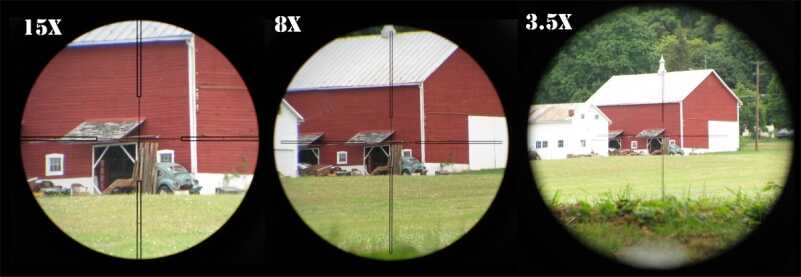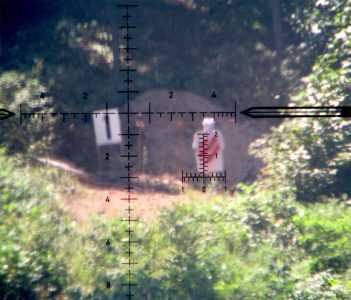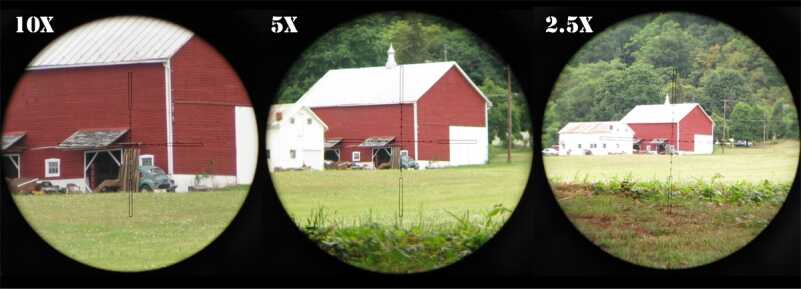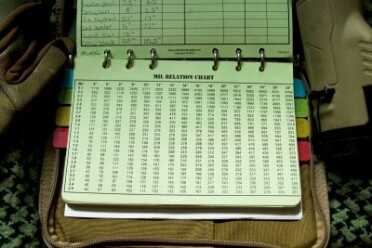For more information or to purchase a Mil-dot Master, visit: mildot.com.
For data book sources visit: ustacticalsupply.com or impactdatabooks.com.

In the film 28 Weeks Later, the main character was forced to rapidly engage multiple targets from an elevated position. Image courtesy 20th Century Fox.
In the movie 28 Weeks Later, Jeremy Renner’s character plays an Army sniper that is in the midst of a population of persons infected with a deadly rage virus. In one scene, he has to engage multiple targets from an elevated position. Of course, the whole situation turns bad as things often do in those types of movies, but it brought up an interesting thought. In the fictional scenario that played out, probably the safest way to neutralize the infected would be from long range before they have a chance to get too close. What isn’t shown, like in many movies depicting a sniper, is the work that has to happen before the shot is taken. While it’s no doubt not exciting enough to make it into scenes that have long range shooting, finding the range to a target is a vital component in being able to hit a long distance target. I plan to shed some light on that process for you here.

It’s vital that you know and understand the different subtensions on the reticle. Not knowing can lead to gross ranging errors and missed shots.
I’m sure some of you are saying, “Why not just use a laser rangefinder (to learn more about these, take a look this article at https://www.gunsamerica.com/blog/optics-buying-guide-using-laser-rangefinding-scope/), we’re in the 21st century after all?” It’s true that technology has brought long range shooting a long way to make things faster and more efficient for the shooter, especially within the last decade. In the field of laser rangefinders we once had these large, semi-reliable units that have given way to smaller, more efficient units that can go out to a mile. However, laser rangefinders are still not perfect and there are situations where they will not work properly due to lighting or the nature of the target. In those situations where it becomes necessary to use alternative means to obtain an accurate range to the target, one of the more common methods is to use the reticle inside the riflescope. Mil-dot and other mil-based reticles have been used for years by military and other professional shooters around the globe to not only range a target but also work out hold-over corrections for bullet trajectory. Despite the proliferation of technology into nearly all aspects of shooting, this relatively old school skill is still taught at sniper schools. It’s also a skill that can serve shooters in other disciplines as well.
I’m only going to focus on mils, instead of MOA (to learn more about both types, take a look at this article at https://www.gunsamerica.com/blog/optics-buying-guide-scope-reticles/), because in the movie the shooters were military snipers and mil-dot and mil-based reticles are pretty much the standard in issued optics. The other reason is that mil-based reticles are also more consistent from manufacturer to manufacturer than MOA reticles so there is less chance for confusion or miscalculation. Nearly all modern mil reticles are based on the 6,283 milliradian in a 360° circle specification. This means that you can count on the distance between dots and hash marks being 1 mil, whether it comes from Brand X or Brand Y.
While I hope I haven’t thoroughly confused you yet, allow me to explain what exactly a mil is and what it isn’t. A mil is actually short hand for milliradian, a unit of measure that is used to derive angles from a circle. I have already briefly mentioned that in a 360° circle there are 6,283 milliradian. Just one milliradian covers a linear distance of 3.6 inches at 100 yards, which grows to cover 36 inches at 1,000 yards. If you are used to the metric system, then one milliradian extends 10 centimeters at 100 meters and 1 meter at 1,000 meters, but it’s important to understand that milliradian are not metric. There has been some confusion in the past from those that believe milliradian are metric and therefore in order to use them you have to convert everything to meters. That is simply not the case; milliradian adjustments work just fine for targets that are in inches and yards.

First focal plane optics can be used for ranging at any power setting. Although the reticle is hard to make out on lower settings, it remains the best all around option for tactical use.
There was a time when you only had a few options for a mil reticle but that is pretty much no longer the case as manufacturers now offer a wide variety of mil reticle designs. There are too many of them to list here, but I break mil reticles down into two categories: Basic mil-dot reticles and enhanced mil-based reticles. The basic mil-dot category is pretty self-explanatory and covers those reticles that are simply evenly spaced dots along the vertical and horizontal portions of the reticle. This design dates back to the 1970s when the USMC first adopted a mil-dot reticle in their Unertl 10X riflescopes used on the M40A1. While some people find them to be somewhat obsolete based on current designs, it is still just as effective today as it was years ago. I use a scope with a mil-dot reticle on my designated marksman rifle because I like the simplicity of it and it stands out better against cluttered backgrounds. Enhanced mil-based reticles have essentially become standard options since they include hash marks and other features that make hold over and ranging faster and easier.
When It Counts

The t-shirt in this image is 30 inches tall and 20 inches wide. Use the ranging grid to get an accurate mil reading. How far away is it? Answer is at the end of the article.
Using a mil-dot or other mil-based reticle to range a target isn’t really that different from using a ruler to measure something. There are some things that you need to be aware of though before you get started. The most important thing to know when using the reticle to range a target is the actual size of the target, preferably in inches. Let’s roll back to the movie 28 Weeks Later again and pretend the Army sniper had ranged the infected people before he actually started engaging them. Hypothetically he could’ve ranged nearby objects; however, pressed for time he went with average torso dimensions. Now, the infected aren’t zombies per se because they are not reanimated dead tissue, they are just regular folks that had a run of bad luck and had gone on an enraged killing spree. Luckily that means that hits to the torso and vital organs are still going to be effective at neutralizing them (and not requiring head shots as in the Romero-inspired zombie movies). Using the dimensions of an infected adult isn’t ideal because they can vary in size, which can throw off the chances for a precise range estimate. However, the infected are comparatively large targets so he could be a little off on his mil reading for a 20-inch shoulder width or 36-inch height from waist to top of head and still get a good hit. This is also why it helps to have more than one dimension to go off of so that you can use it to cross-reference the other mil reading and verify the distance. Most data books have a section or two that list various target dimensions or allow you to fill in the dimensions for various targets you might encounter.

It’s essential to know the sizes of objects that you’re ranging. Plug 30 in. and 1.7 mils into the formula to get a range of 490 yards.
Aside from knowing the target’s dimensions, the next most important things to know are the reticle’s subtensions and how to accurately break it down into tenths of a mil. If you know the size of the various parts of the reticle in mils you can use those to get an accurate mil reading and minimize errors that could provide you a false distance. This is why enhanced mil-based reticles have become standard in many manufacturer’s scopes, because they provide easy-to-see stadia lines that can provide a mil reading to the tenth mil or better. Most manufacturers today have downloadable pages on their websites that show all of the various subtensions of the reticle in great detail. It’s advisable to print these off and keep a copy tucked away in your data book or field notebook.
So you know your target dimensions, you’re familiar with the reticle and you have a reading for both the height and width of the target. You now have to convert that into some kind of distance. There are a few different methods that you can use, any one of which can be easily stored in a pocket or data book. The first method is to use a calculator to plug in the target size and mil reading to come up with the distance. This method is probably the most accurate but it is also slower; not good if you’re say facing down a horde of crazies. There are actually two formulas, one for if you are calculating the distance in yards and the other if you are calculating the distance in meters. They go like this:

Understand that there are a couple of other formulas that you can use to that are similar to the above two. However, I prefer these. One of the alternate formulas requires the target dimension to be input in yards; quick, what’s 8 inches in yards? Exactly. Yet another one uses target dimensions in centimeters instead of inches. Here in the United States we’re used to seeing things in inches, so I feel like it’s more natural to use the above formulas. It’s also the way I was taught in the Army.

Second focal plane reticles require the magnification to be set to the right power in order to range, in this case, 10X. At any other power setting, there will be errors.
A little trick that was taught to me was to record the constants for some of the more common targets if you plan to use the reticle to range often. The constant is obtained when you multiple either 27.8 or 25.4 by the size of the target in inches. This will cut down on the number of steps you have to take to get a range and is therefore faster.

If you don’t have a calculator or it suffered an untimely demise you can use a product called a Mil-Dot Master. I was issued these when I was in the Army and it’s an analog slide rule that allows you to quickly calculate the range to a target in both yards and meters. It took a little getting used to for me but after that I found that I could quickly line up the target size with the proper mil reading to have a range in just seconds. Finally, you can use what is called a mil relation chart that is in some ways like a multiplication table for target sizes and mil readings. It’s a fast, down, and dirty way to figure out a range to the target, but it’s not without its limitations. To use it you find the target size along the top of the chart and the mil reading you got for that target. Trace your finger over to where they intersect and you’ll have the distance to the target. The main drawback to this method though is that if the target size isn’t listed you won’t be able to get an accurate range estimate.
Devil’s In The Details

The Mildot Master has been issued to US forces for over a decade. Its simplicity and accuracy allow you to range long-distance targets without a calculator.
There are a few things that have to be taken into account when you are using the reticle to range a distant target, otherwise you could likely come up with an inaccurate estimate. The first is you have to be sure that the scope’s magnification is set to the proper power setting. This is especially the case with second focal plane optics because the reticle’s subtensions are only accurate at one power setting. This is not a problem for first focal plane optics because the reticle will be correct regardless of the magnification setting. In hot climates, beware of mirage that can obscure the edges of the target and make it hard to get an edge-to-edge reading. In very bright light, this same issue can manifest itself if the target is very light in color, causing it to almost wash out.
One way to work around both of those issues is to lower the magnification setting. However, also be aware of any additional conversions you have to make if you use a second focal plane optic. If you go to the halfway point in the power range, 1 mil becomes 2 mil and so forth so you’d have to cut your mil reading by half to be accurate. The shooter must also consider the target’s orientation to the shooter. If the target is not facing the shooter squarely it is going to skew the mil reading and provide inconsistent results. If the target is angled to the side, try to focus on getting a good mil reading of the height. If it is angled down or away from you, you should focus on getting a good reading of the width.

Mil relation charts are an excellent way to get a range quickly if time is a factor. I keep this one in my data book at all times.
All of this is essentially to get to a point where you can put your finger on a dope chart to work out what elevation and windage data you need to use to hit the target. I promise that in real life it goes much faster once you have a working knowledge of how to use the reticle. Practicing as much as you can pays off in maintaining this perishable skill. There are various methods that you can use, but the online game ShooterReady is a fantastic way to get started on learning the ins and outs. At the range, you can practice on reduced-scale targets to work on breaking down the reticle and getting a range using one of the methods above. While it may not seem like a critical skill it is one that can be useful one day when the batteries run out and you need to defend yourself or put meat on the table. Or, if you are ever facing that horde of rage-induced zombies!
Answer to ranging question in the photo: The distance to the target is 430 yards, confirmed with a Leica 1200CRF. If your range estimate is within 5% of that you are good to go.
For more information or to purchase a Mil-dot Master, visit: mildot.com.
For data book sources visit: ustacticalsupply.com or impactdatabooks.com.


Zombie’s, Vampires, Werewolves, Big Foot, whatever. Good information for those who never served, or forgot what they were taught. Plug in insurgents, rioters, communists, or any other hostile bad guys, and it works just as well. Just the term zombie makes it slightly more palatable to the PC and squeamish types.
Since I was a military sniper about 45 years ago, this was a nice refresher course and reminder. Thank you.
The zombie apocalypse is here and it’s more like the 28 Days series of fast moving vicious zombies rather than the slow moving ones depicted in Night of the Living Dead and The Walking Dead. The zombies we have now still know how to riot, loot, set fires, throw objects, aim lasers and kill cops and innocent people. I never thought I’d see a true zombie apocalypse but here we are. They were first spotted in Minneapolis and soon spread to other American cities. Portland Oregon seems to be a hot spot full of them but there has been evidence that they have acquired buses to get from town to town and vans to deliver to them weapons and shields to give them more power. This is not how I pictured the zombie apocalypse but we don’t get to pick what mother nature (or George Soros) throws at us.
What is that scope you were using?
thanks
Outstanding article!
Speaking of zombies only:
A zombie more than 200 yards away is somebody else’s zombie.
Thank You – that was the best education on “mil-dot” I have received. I have no military experience and all other explanations from others tended to loose me.
… Which is why I have ended up with MOA optics – that will now change!
Yes perhaps “hostile(s)” would have been better than “zombies” however it does inject a little humour into a serious subject. Besides, IF there were an unspecified “event” that left a large portion of the population without food or water…
I know I’m not the only gun enthusiast that thinks this zombie crud is an embarrassing excuse for massive firepower.
We might as well be talking about the real thing: being able to kill lots of people. There, doesn’t that sound nice?
Replace zombie with sheep. No wait, PETA will get upset… nevermind.
Some folks commenting here need to pull the stick outa their ass……….
In a world where gun owners are portrayed as nuts by the liberal media and the Washington gun grabbers, you feed the fire with this kind of off the wall juvenile crap. Just WTF are you thinking? Zombies, come on. That was some idiot’s idea for a movie years ago that flopped until some weirdo decided that there were people gullible enough to grab onto the idea and make it a viable marketing tool for high priced ammo and tricked out guns. Save your money for real life targets like terrorist.
May I be excused? My brain is full.
Excellent article. I’m always looking for ways to expand my knowledge of long range shooting; whether it be range calculation (sizing targets, etc), or learning more about wind drift and elevation. I’m ecstatic to try the Shooter Ready game, nothing beats real trigger time, but real education from an expert that saves ammo has to have some potential. Never mind the nay sayers, all around interesting article.
“Awaiting moderation”
This has to be the stupid capitol of the internet.Make gunsmithing an acceptable occupation,quit screwingit up with wild out of the world junk you publish. Any competent gunsmith knows half of this stuff you splash over the airways is junk and probably never happened. With a camera you can present any senario.Ken Sawyer.Get some respect backinto our use to be respected profession.
Does anyone know how stupid it makes firearms dealers look to the world when we talk about zombies? You won’t print this just as you have stopped everything I have sent. It is time dealers act like they have some sense and the people who make firearms with comic book names.
Zombie apocalypse? No wonder we are having so many issues here in the USA as I read that 22-28 percent believe in this zombie apocalypse nonsense. A better title might have been (How to determine range using one’s scope reticle.).
You can also lump in all of the Yeti and big foot nonsense. Yet there has never been found any bones of these supposed beings. Just proves “ignorance is bliss” and with that being the case we should have many happy people.
Don’t forget the flat-Earthers and believers in the magical sky buddy.
You actually read that? Where?
WHAT is this obsession with zombies and vampires? Geeze. It’s getting old.
Prefer nightclub patrons?
Yeah, until society gets over being politically correct you get Zombies and Vampires,
unless of course the media makes a case for their feelings…….
Thanks for your comment. I see everyone getting bent out of shape because the writer used. “zombies” as a place holder in order not to offend someone’s sensibilities. Maybe “hostile forces” would have worked better but it doesn’t really make any difference when you’re dealing with thin skinned commentors.
“Zombie” works fine, unless your interested in the liberal media taking these conversations out of context and using this useful information against those who woul protect gun right in America. Plug in “islamist” or “communist” or “foreigners living in our midst” and just learn your lesson. Noob.
I agree. Most people are ignorant. It’s clear that the word zombie is just to fill in the blanks. After a collapse 90 percent of the unprepared population will be zombies in the mediforical sense.
Read the info and use it. Forget about the presentation people!
Good article.
Mediforical? How about metaphorical?